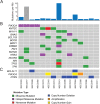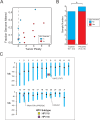Comparative genomics of high grade neuroendocrine carcinoma of the cervix
- PMID: 32544169
- PMCID: PMC7297329
- DOI: 10.1371/journal.pone.0234505
Comparative genomics of high grade neuroendocrine carcinoma of the cervix
Abstract
In order to improve treatment selection for high grade neuroendocrine carcinomas of the cervix (NECC), we performed a comparative genomic analysis between this rare tumor type and other cervical cancer types, as well as extra-cervical neuroendocrine small cell carcinomas of the lung and bladder. We performed whole exome sequencing on fresh-frozen tissue from 15 NECCs and matched normal tissue. We then identified mutations and copy number variants using standard analysis pipelines. Published mutation tables from cervical cancers and extra-cervical small cell carcinomas were used for comparative analysis. Descriptive statistical methods were used and a two-sided threshold of P < .05 was used for significance. In the NECC cohort, we detected a median of 1.7 somatic mutations per megabase (range 1.0-20.9). PIK3CA p.E545K mutations were the most frequency observed oncogenic mutation (4/15 tumors, 27%). Activating MAPK pathway mutations in KRAS (p.G12D) and GNAS (p.R201C) co-occurred in two tumors (13%). In total we identified PI3-kinase or MAPK pathway activating mutations in 67% of NECC. When compared to NECC, lung and bladder small cell carcinomas exhibited a statistically significant higher rate of coding mutations (P < .001 for lung; P = .001 for bladder). Mutation of TP53 was uncommon in NECC (13%) and was more frequent in both lung (103 of 110 tumors [94%], P < .001) and bladder (18 of 19 tumors [95%], P < .001) small cell carcinoma. These comparative genomics data suggest that NECC may be genetically more similar to common cervical cancer subtypes than to extra-cervical small cell neuroendocrine carcinomas of the lung and bladder. These results may have implications for the selection of cytotoxic and targeted therapy regimens for this rare disease.
Conflict of interest statement
Dr. Byers reports grants and personal fees from AbbVie, grants and personal fees from AstraZeneca, grants and personal fees from GenMab, grants from Tolero Pharmaceuticals, grants from Sierra Oncology, personal fees from BergenBio, personal fees from Pharma Mar, SA, all of which are outside the submitted work. The remaining authors report no conflicts of interest related to this work. This does not alter our adherence to all the PLOS ONE policies on sharing data and materials.
Figures




References
-
- Wang K.-L., Chang T.-C., Jung S.-M., Chen C.-H., Cheng Y.-M., Wu H.-H., et al., Primary treatment and prognostic factors of small cell neuroendocrine carcinoma of the uterine cervix: a Taiwanese Gynecologic Oncology Group study., Eur. J. Cancer. 48 (2012) 1484–94. 10.1016/j.ejca.2011.12.014 - DOI - PubMed
-
- Frumovitz M., Munsell M.F.F., Burzawa J.K.K., Byers L.A.A., Ramalingam P., Brown J., et al., Combination therapy with topotecan, paclitaxel, and bevacizumab improves progression-free survival in recurrent small cell neuroendocrine carcinoma of the cervix., Gynecol. Oncol. 144 (2017) 46–50. 10.1016/j.ygyno.2016.10.040 - DOI - PMC - PubMed
-
- Roth B.J., Johnson D.H., Einhorn L.H., Schacter L.P., Cherng N.C., Cohen H.J., et al., Randomized study of cyclophosphamide, doxorubicin, and vincristine versus etoposide and cisplatin versus alternation of these two regimens in extensive small-cell lung cancer: a phase III trial of the Southeastern Cancer Study Group., J. Clin. Oncol. 10 (1992) 282–91. 10.1200/JCO.1992.10.2.282 - DOI - PubMed
Publication types
MeSH terms
Substances
Grants and funding
LinkOut - more resources
Full Text Sources
Medical
Molecular Biology Databases
Research Materials
Miscellaneous

